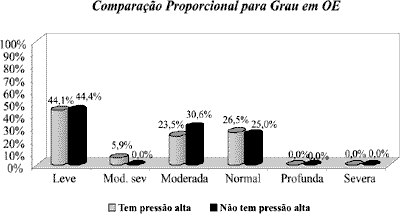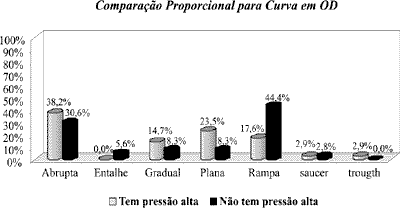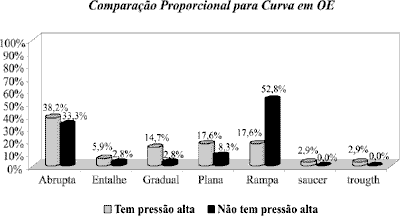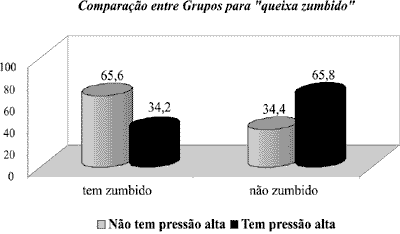INTRODUCTIONPopulation aging has been part of the world scene as a result of progressive increase of average life expectancy, related to reduction in mortality and birth rates. In Brazil, according to the last Census (2000), the elderly population corresponds to 5.85% of the population, with 1.02% increase in comparison to the previous Census from 1991. The aging index has also went up from 13.90% in 1991 to 19.77% in 2000.
As a result of aging, there is increase in the number of chronic diseases, among which high arterial blood pressure, a significant cardiovascular risk 1. The prevalence of high blood pressure (HBP) in the elderly, according to American data, indicates that since 1900 the percentage of hypertensive people aged over 65 years has tripled (4.1% to 13.0%), and the number had a 10-fold increase (3.1 to 31.2 million)². Arterial blood pressure comprises systolic blood pressure (SBP) of 140 mmHG or greater and diastolic blood pressure (DBP) of 90 mmHg, as determined by the VI Joint National Committee³.
Considering that it is a chronic disease, it is known that in general advanced age is associated with greater impairment of senses, and hearing is one of the essential senses for communication. It is known that hearing loss has adverse effects over functional state, quality of life, cognitive function and emotional behavior and social wellbeing of elderly subjects. In some studies with elderly subjects, according to variables gender and age, there is prevalence of 63% of hearing loss.
Hearing loss resultant from aging is known as presbyacusis and it is associated with specific audiological characteristics, and sensorineural hearing loss: in general, descending, bilateral and symmetrical. According to the Committee on Hearing, Bioacoustics and Biomechanics, presbyacusis was defined as the sum of hearing losses that result from different varieties of physiological degeneration, including damage caused by noise exposure, ototoxic agents and medical disorders and treatments, and the main functional characteristics are gradual descending changes to auditory sensitivity in all frequencies, followed by decrease in speech discrimination and complex decrease of central auditory function, which are manifested by increased difficulties in auditory skills such as auditory merger, attention, judgment, varied behaviors and reduction in auditory closure and synthesis speed. There are many factors involved in the etiology, such as noise exposure, diet, hypertension, metabolic and hereditary factors.
SBP - DBP ratio in cardiovascular events is equally significant in people aged more than 65 years, when compared to subjects aged 35 to 64 years 1. In turn, presbyacusis is defined in the strict sense as hearing loss assessed in subjects at the 5th decade of life or resulting exclusively from changes related to age, possibly of genetic basis.
Therefore, considering cochlear activity changes that occur as a result of metabolic diseases and the prevalence of high blood pressure and hearing loss in elderly subjects, it is believed that hypertension can cause damage to the auditory system. Owing to that, in order to prevent and detect auditory deficits resultant from aging, the purpose of the present study was to compare and analyze the results of clinical history and pure tone audiometry in high-blood pressure and normal elderly patients.
METHODBased on the rules advocated by experiments with human beings, the present study was analyzed and approved by the Research Ethics Committee, Federal University of Sao Paulo, as provided by resolution CEP n° 0669/03 of National Health Council.
Concerning the used sample, the study gathered elderly patients referred by the Institute of Geriatrics and Gerontology, UNIFESP, to conduct audiological assessment in the period of March to November 2003. Seventy elderly subjects were analyzed, aged between 60 and 92 years, 15 male and 54 female. Diagnosis of high blood pressure was classified according to the medical criteria and we enrolled only clinically controlled patients.
First of all, subjects underwent clinical history, comprising issues related to harmful habits to the auditory system, hearing acuity, and functioning in the social environment, such as data referring to difficulty to understand speech in noise and telephone conversation, need to put up TV volume; social deprivation because of auditory deficit; otological history, presence of tinnitus and dizziness.
After the anamnesis, elderly patients were submitted to basic audiological assessment, conducted in soundproof booth, including the following procedures:
" Pure tone audiometry: performed with audiometer model AC33, brand Interacoustics, calibrated according to norm ANSI 69.
" Speech Audiometry: Speech Recognition Threshold (SRT) and Speech Recognition Index (SRI).
" Acoustic Immittance Measures: Tympanometry and Contralateral Acoustic Reflex, performed with Immittanciometer model AZ7, brand Interacoustics.
" Audiometry was classified depending on levels as mild, moderate, moderately severe, severe and profound, according to the criteria defined by Lloyde and Kaplan 1978.
" Audiometric configurations were classified as: flat, gradual, abrupt and slope, according to the criteria of main category defined by Lloyde and Kaplan 1978, to classify descending curves.
To interpret the results, we used ANOVA test, Two-proportion test, Chi-square test and also descriptive analysis with confidence interval.
RESULTSBased on the study objective, data obtained from both groups were analyzed - elderly with high blood pressure and elderly without high blood pressure - and compared according to level and configuration of hearing loss and history data. Level of significance used for statistical comparisons was 0.05 (5%).
Initially, we present the results of the complete descriptive analysis for levels of hearing loss, both with and without high blood pressure. It is important to highlight that we defined intervals (upper and lower limits) with 95% statistical confidence.
Figure 1. Distribution of level of hearing loss in the studied groups on the right ear (RE).

Mild/Moderately severe/Moderate/Normal/Profound/Severe
Has high blood pressure/ Does not have high blood pressure
Figure 2. Distribution of level of hearing loss in the studied groups on the left ear (LE).

Mild/Moderately severe/Moderate/Normal/Profound/Severe
Has high blood pressure/ Does not have high blood pressure
We made sure that there were no proportional differences between the groups with statistically significant difference at all levels.
Next, we present the results for types of audiometric configuration.
Figure 3. Distribution of types of audiometric configuration in the studied groups on the right ear.

Abrupt/Notch/Gradual/Flat/Slope/Saucer/Trough
Has high blood pressure/ Does not have high blood pressure
Figure 4. Distribution of types of audiometric configuration in the studied groups on the left ear.

Abrupt/Notch/Gradual/Flat/Slope/Saucer/Trough
Has high blood pressure/ Does not have high blood pressure
There was statistically proportional difference between the groups for level of slope curve. This difference was present both on the right and left ears. We detected that the group without high blood pressure was the one with highest statistical recurrence of this type of curve.
In the Graph that follows, we present history data that presented relevance concerning the studied groups.
Figure 5. Distribution of frequency of occurrence of tinnitus complaint.

Has tinnitus //Does not have tinnitus
Has high blood pressure/ Does not have high blood pressure
Comprising tinnitus and HBP, we detected that there was dependence and/or statistical association, in which non-hypertensive subjects were more prone to present this type of complaint, p-value = 0.009*.
DISCUSSIONIn Brazil, high blood pressure is one of the most important cardiovascular risk factors, affecting about 20% of the elderly population aged over 65 years, in the city of Sao Paulo. Epidemiological studies indicate an even higher prevalence of 62% among elderly subjects 1. In turn, hearing loss affects about 24% of the population between 65 and 74 years of age, and 39% in the population range over the age of 75 years 11.
The correlation between hypertension and hearing loss has been widely studied in the literature, though clinical and histopathological data and findings are very controversial.
Some studies justify that sensorineural deafness would occur as a result of microcirculation failure caused by vascular occlusion by embolism, hemorrhage or vasospasm and that they would be the product of a hyperviscosity syndrome of microangiopathy caused by diabetes or hypertension, advocating that hypertension could cause sensorineural hearing loss through these histopathological factors ¹². Others state that isolated HBP would not generate more hearing loss than expected in the population with normal blood pressure 13, whereas hypertension associated with other factors such as tension, noise exposure, genetic predisposition could possibly cause significant loss in hearing 1.
Since we believed in close relation between hypertension and hearing loss, the present study tried to investigate audiological findings comparing groups of high blood pressure and normal blood pressure elderly subjects. The first piece of data found was the level of hearing loss: there were no statistically significant differences between the two studied groups. Differently from the reports found in the literature, the group of high blood pressure subjects did not present higher level of hearing loss than elderly with normal pressure, presenting similar levels of hearing loss.
Concerning types of studied audiometric configuration, there was proportionally significant difference between the two groups of high blood pressure and normal blood pressure elderly, for slope audiometic curve. This difference was present both on the right and left ears, noticing that the slope configuration was the most recurrent one in elderly patients with normal blood pressure. Concerning audiometric configuration, it was observed that flat configuration was the most frequent among hypertensive elderly subjects compared to non-hypertensive ones, a fact discussed in the literature. Given that combined histological evidence and audiological findings could delimit specific types of presbyacusis, one of them is the origin from stria degeneration or metabolic origin from stria vascularis. This type of loss would generate changes to cochlear electrical potential with possible effects over energy production in Corti's organ, resulting in flat audiometric configuration, normally followed by good speech recognition 1. These data raise the possibility that hypertensive elderly patients have degeneration focus on stria vascularis, which justifies the flat audiometric configuration. Another study agreed with the data, revealing that stria vascularis atrophy can produce essentially horizontal hearing losses of up to 60dB even in people with preserved hair cells. The most frequent causes of stria vascularis atrophy are metabolic diseases 1.
Even so, among the obtained results, we could detect that there was statistical dependence and/or association between tinnitus and HBP, and non-hypertensive subjects were more prone to have this type of complaint. Tinnitus is normally associated with cochlear hair cell loss 1 and in some studies with elderly populations it was possible to detect the occurrence of tinnitus in a relevant portion of the sample 1. Tinnitus is considered a symptom and not a disease and its etiological mechanism is uncertain: some studies suggest that it may be a consequence from abnormal neural activity, resulting from damage or dysfunction at any level of the auditory system 1. Other authors suggest that tinnitus can occur owing to metabolic abnormalities, high cholesterol levels, head trauma and vascular problems 2. Tinnitus may be classified as objective and subjective, and subjective tinnitus is very common in elderly and normally described as an echo sound that is vibrating and resonant 21.
Tinnitus affects about 7% of the population and about 1% of the subjects consider it a disabling problem 2. In a study with 50 high blood pressure subjects aged 20 to 75 years, tinnitus was referred by 52% of the cases, a fact that was not observed in the present study in which only 32.4% of high blood pressure elderly subjects manifested this symptom. In another audiological study with 50 subjects with high blood pressure aged 45 to 63 years, 36% had complaints of tinnitus 22, a value that is closer to the one found in our study (32.4%). The fact that our HBP subjects presented less tinnitus complaints may be related to control of hypertension, given that all studied subjects were under treatment with clinically controlled hypertension. These data may be confirmed by the literature because drugs such as notrptyne and tricyclical antidepressants seem to have good effect, as well as psychological support, meaning that placebo usually leads to improvement in some patients with tinnitus complaints 1.
However, in the present study we did not observe correlation between hearing loss and hypertension because audiological data found for high blood pressure and normal pressure subjects were similar. Such data are in agreement with literature reports that tried to define the occurrence of hearing loss in clinically controlled hypertensive patients and according to the results, they considered that long evolution HBP did not cause significant deterioration of hearing ²³.
Finally, hypertension should not be considered a causing factor of hearing loss, but for long periods of time and associated with aging, it may act as an adding factor in deterioration of the auditory system.
CONCLUSIONConcerning audiological findings in the studied groups, we could observe that:
" Concerning level of hearing loss, both groups presented similar characteristics;
" Concerning audiometric configuration, non-hypertensive elderly group predominantly presented slope configuration, whereas hypertensive elderly patients had flat configuration;
" Non-hypertensive elderly patients more frequently had complaints of tinnitus.
REFERENCES1. Bodanese LC. Hipertensão Arterial no idoso. Rev Bras Clin Ter 1998; 24(5):194-9.
2. American Association of retired persons. A profile of older Americans. Washington; 1990.
3. Joint National Committee. The sixth report of the Joint National Committee on prevention detection evaluation and treatment of high blood pressure. Arch Intern Med 1997; (157):2413-46.
4. Sangster JF, Gerace TM, Seewlad RC. Hearing loss in elderly patients in a family practice. Can Med Assoc J 1991; 144(8): 981-4.
5. Russo ICP. Achados audiométricos em uma população de idosos presbiacúsicos brasileiros em função do sexo e da faixa etária. Pró-fono 1993; 5(1): 8-10.
6. Committee on hearing bioacoustics and biomechanics, 1988.
7. Bess FH, Williams HA, Lichtentein MJ. Avaliação audiológica dos idosos. Em: Miusiek FE, Rintel-Nann WF. Perspectivas atuais em avaliação audiológica. Manole; 2001. p. 343-69.
8. Lloyd LL, Kaplan H. Audiometric interpretation: a manual of basic audiometry. Baltimore: University Park Press, 1978.
9. Olmos RD, Lotufo PA. Epidemiologia da hipertensão arterial no Brasil e no mundo. Ver Bras Hipertens 2002; 9: 21-3.
10. Miranda RD, Perrotti TC, Bellimazzi VR, Nobrega TM, Cendoroglo MS, Toniolo Neto J. Hipertensão arterial no idoso: peculiaridades na fisiopatologia, no diagnóstico e no tratamento. Ver Bras Hipertens 2002; 9:293-300.
11. Roehe MV, Porsch H, Moussalle S. Presbiacusia. ACTA MED. (PORTO ALEGRE) 1994;15:97-101.
12. Carrasco VN, Prazma J, Faber JE. Cochlear microcirculation effect of adrenergic agonists on arteriole diameter. Arch Otolaryngol Head Neck Surg 1990; (116): 411-7.
13. Leits CMA. A vascular changes in hypertension. Med Clin North Am 1987; 71(5): 827-41.
14. Nazar J, Otarola F, Acevedo L. Audition del paciente hipertenso crônico controlado. Ver Otorrinolaringol Cir Cabeza Cuello 1992; 52: 97-104.
15. Schuknecht HF. Further observations on the pathology of presbycusis. Archives of Otolaryngology 1964; (80): 369-82.
16. Albernaz PLM. Aspectos otoneurológicos da velhice. Acta AWHO 1982; 1(3): 93-5.
17. Bilton T, Ramos, RR, Ebel S, Teixeira LS, Tega LP. Prevalência da deficiência auditiva em uma população idosa. Mundo da Saúde 1997; 21(4): 218-25.
18. Ebel SJ. Prevalência de sintomas e sinais otoneurológicos em pacientes idosos com queixas de tontura [dissertação]. (SP): Universidade Federal de São Paulo; 1994.
19. Ribeiro PJ. Iorio CMM, Fukuda Y. Tipos de zumbido e sua influencia na vida do paciente: estudo em um população ambulatorial. Acta AWHO 2000; 19(3): 125-35.
20. Dossini L, Ravanelli R, Moussalle S. Queixas Otorrinolaringológicas do idoso. Acta Medica [Porto Alegre] 1997; (1): 109-21.
21. Colafemina JF, Grellet M. A função do labirinto anterior e posterior no paciente com hipertensão arterial. Ver Bras De Otorrinolaring 1985; 51(1): 27-30.
22. Brohen VMA, Caovilla HH, Ganança MM. Dos sintomas e achados audiológicos e vestibulares em indivíduos com hipertensão arterial. Acta AWHO 1996; 15(1): 4-10.
23. Yan-Lin C, Ding YP. Relationship between hypertension and hearing disorders in the elderly. East African Medical Journal. 1999; 76(6): 344-7.


